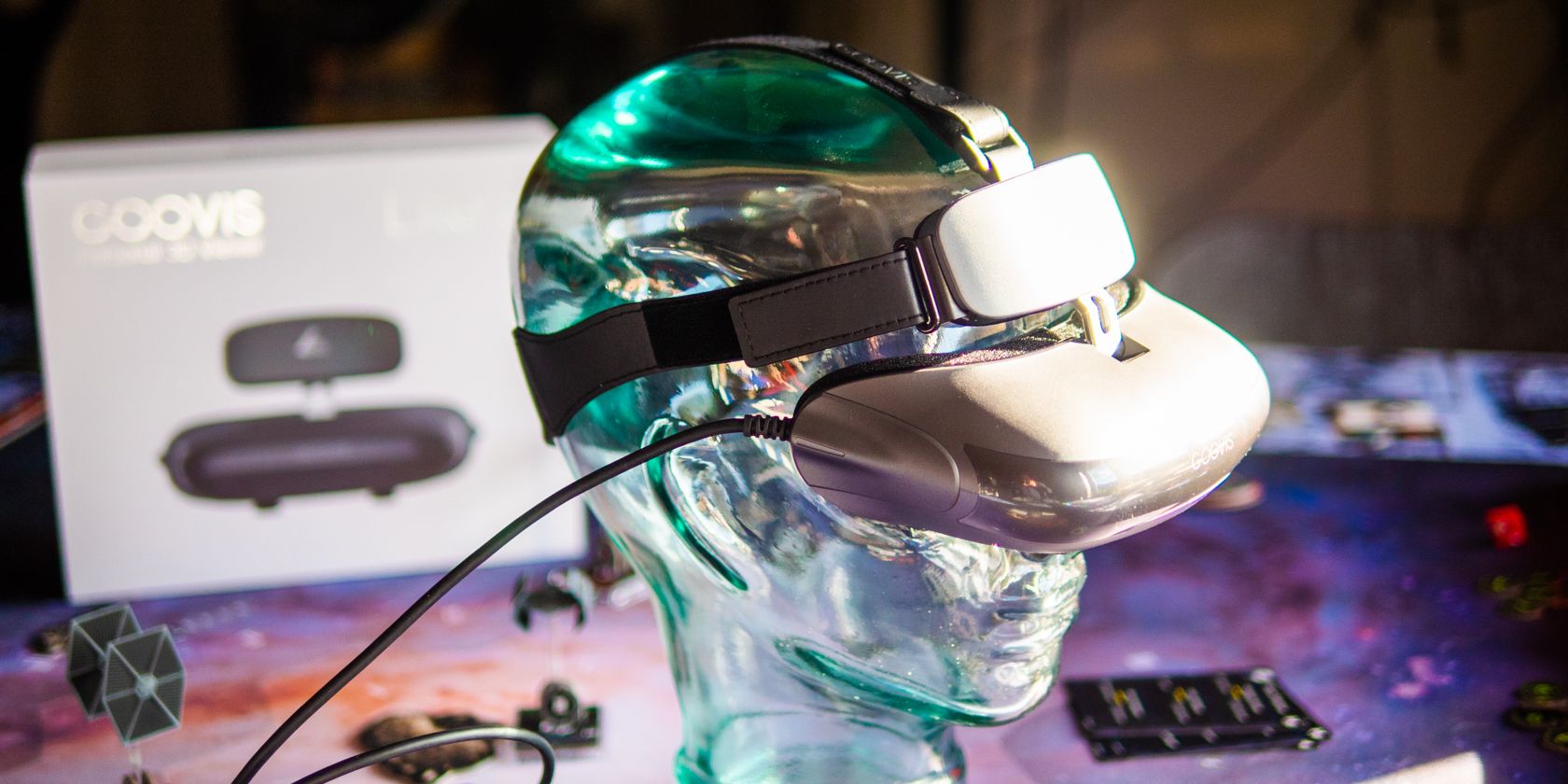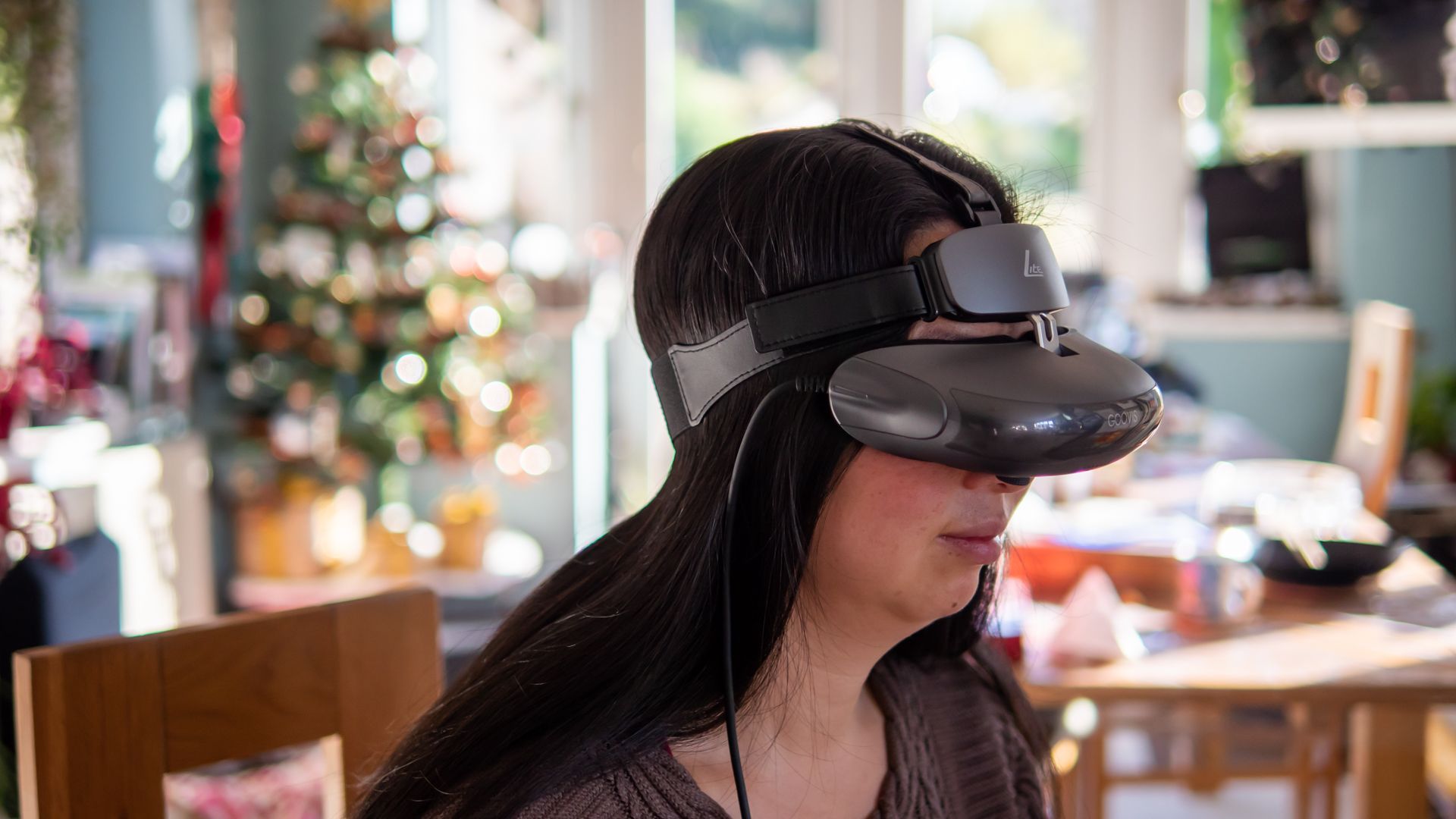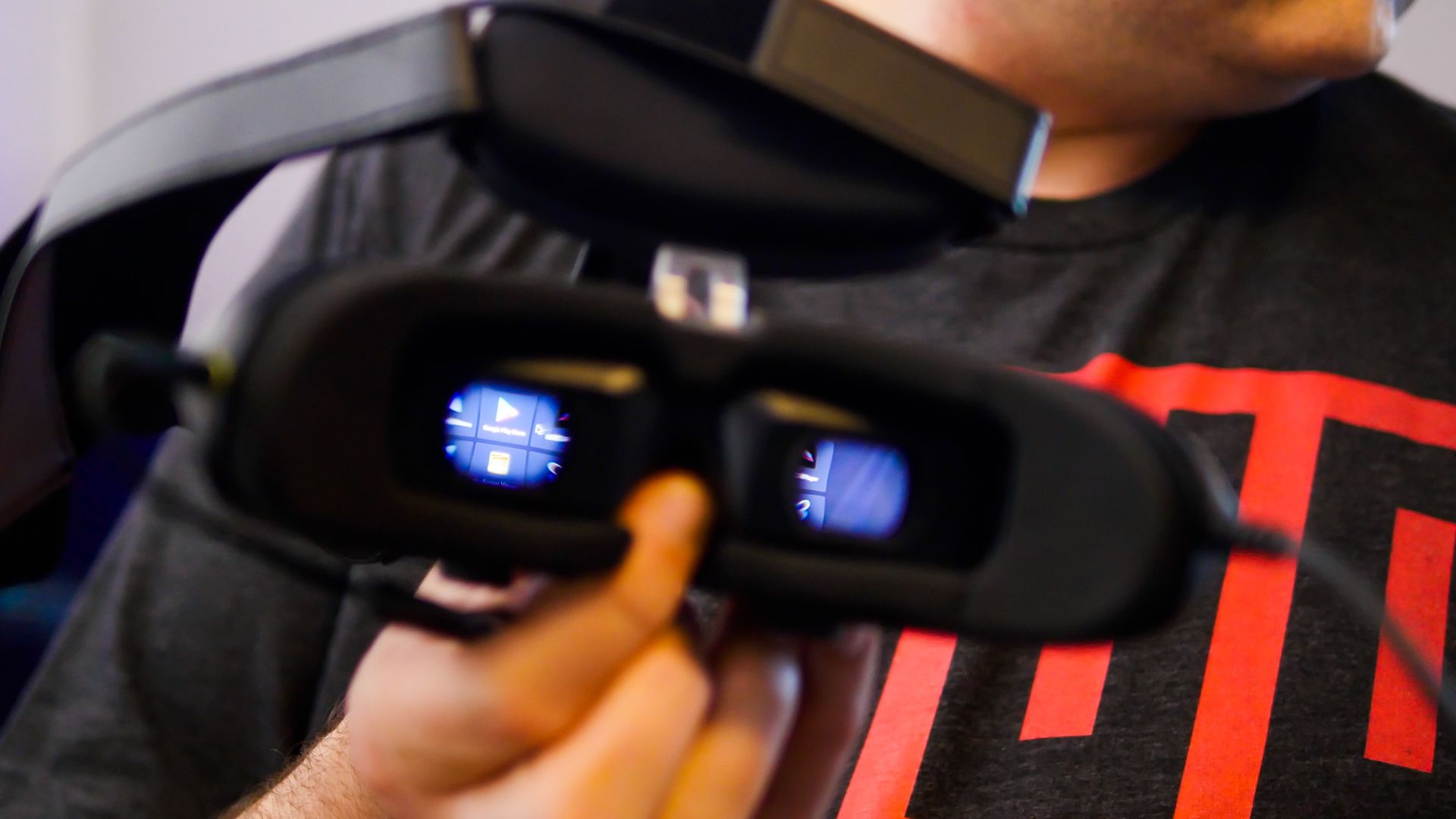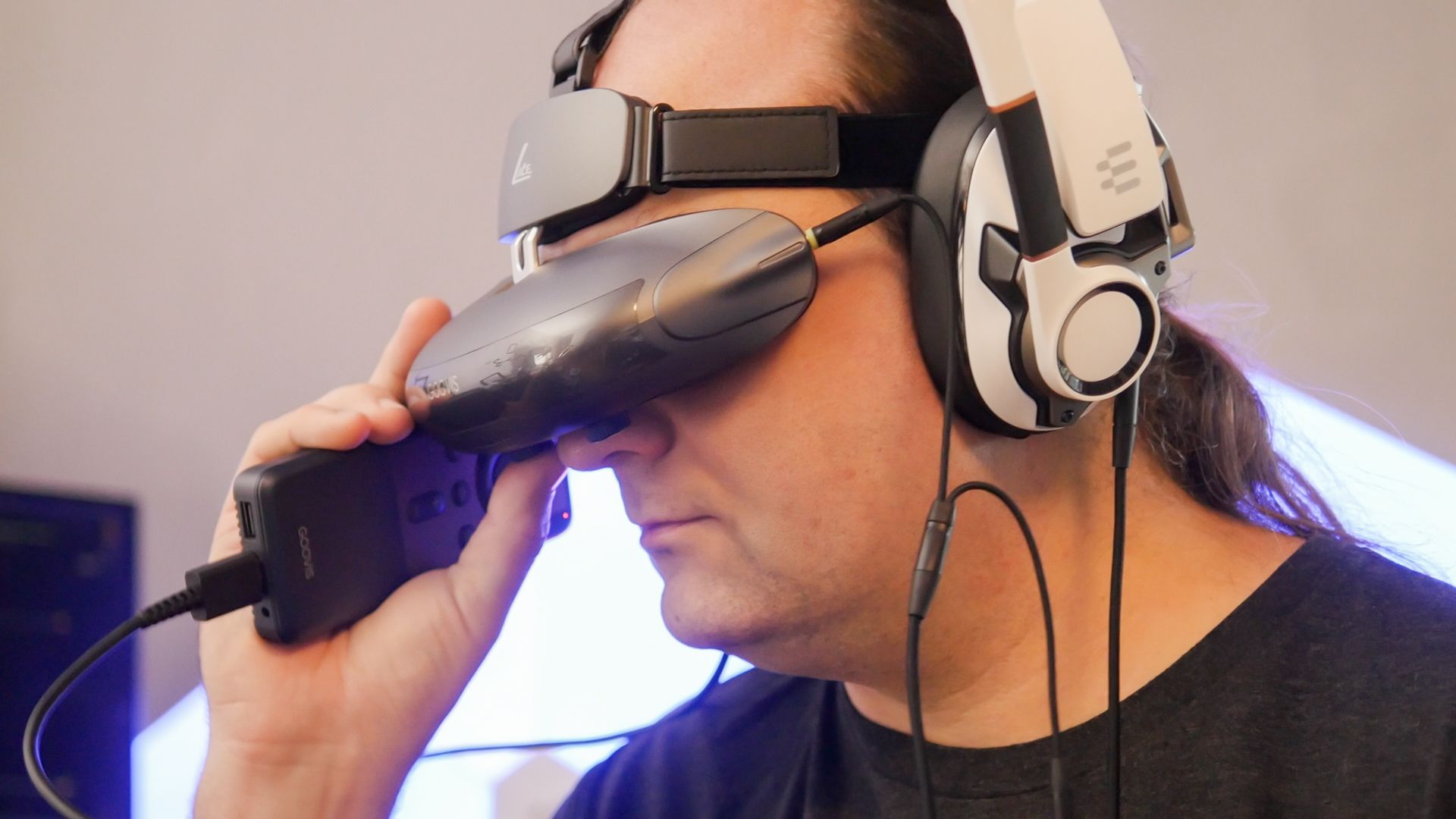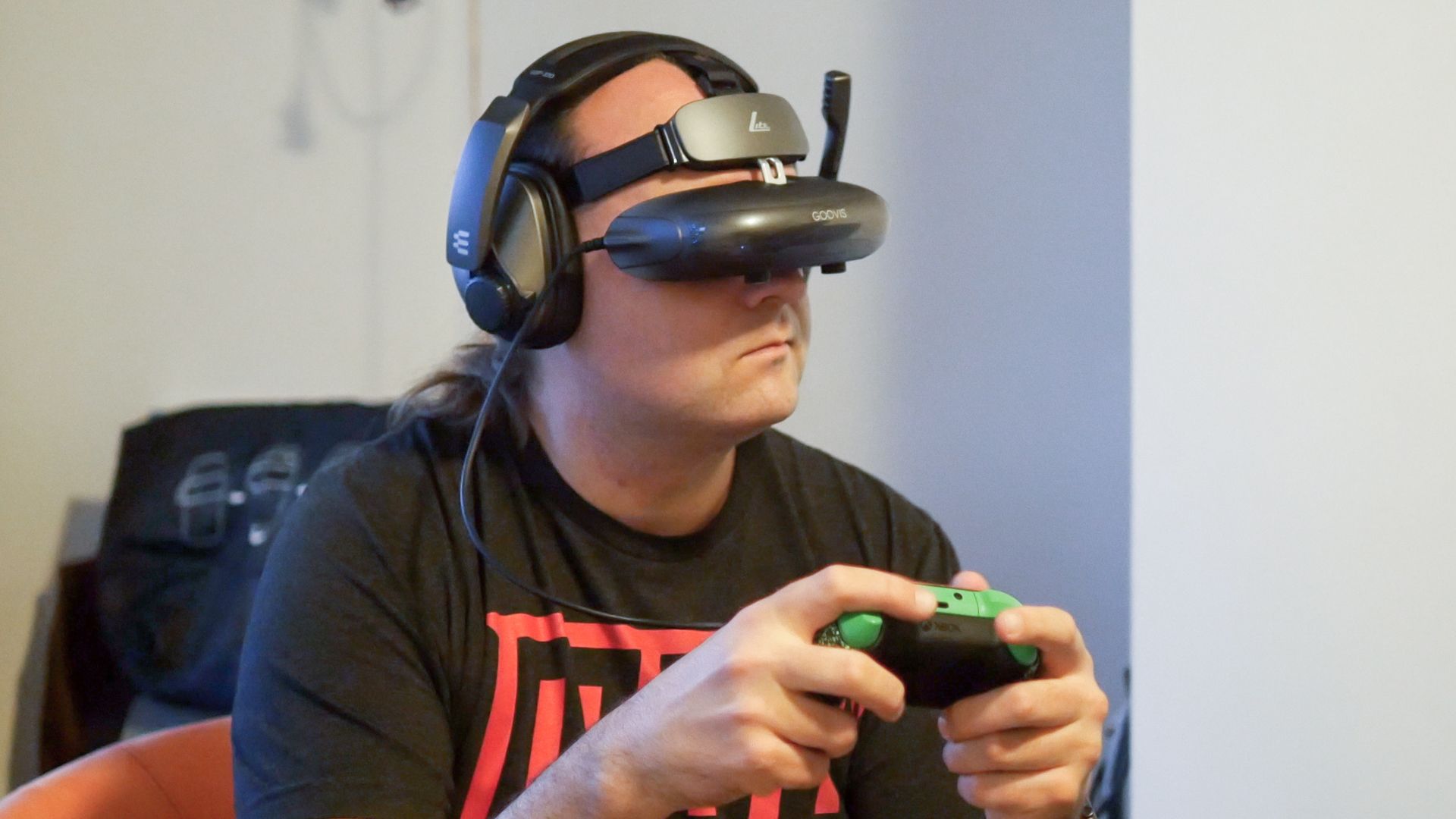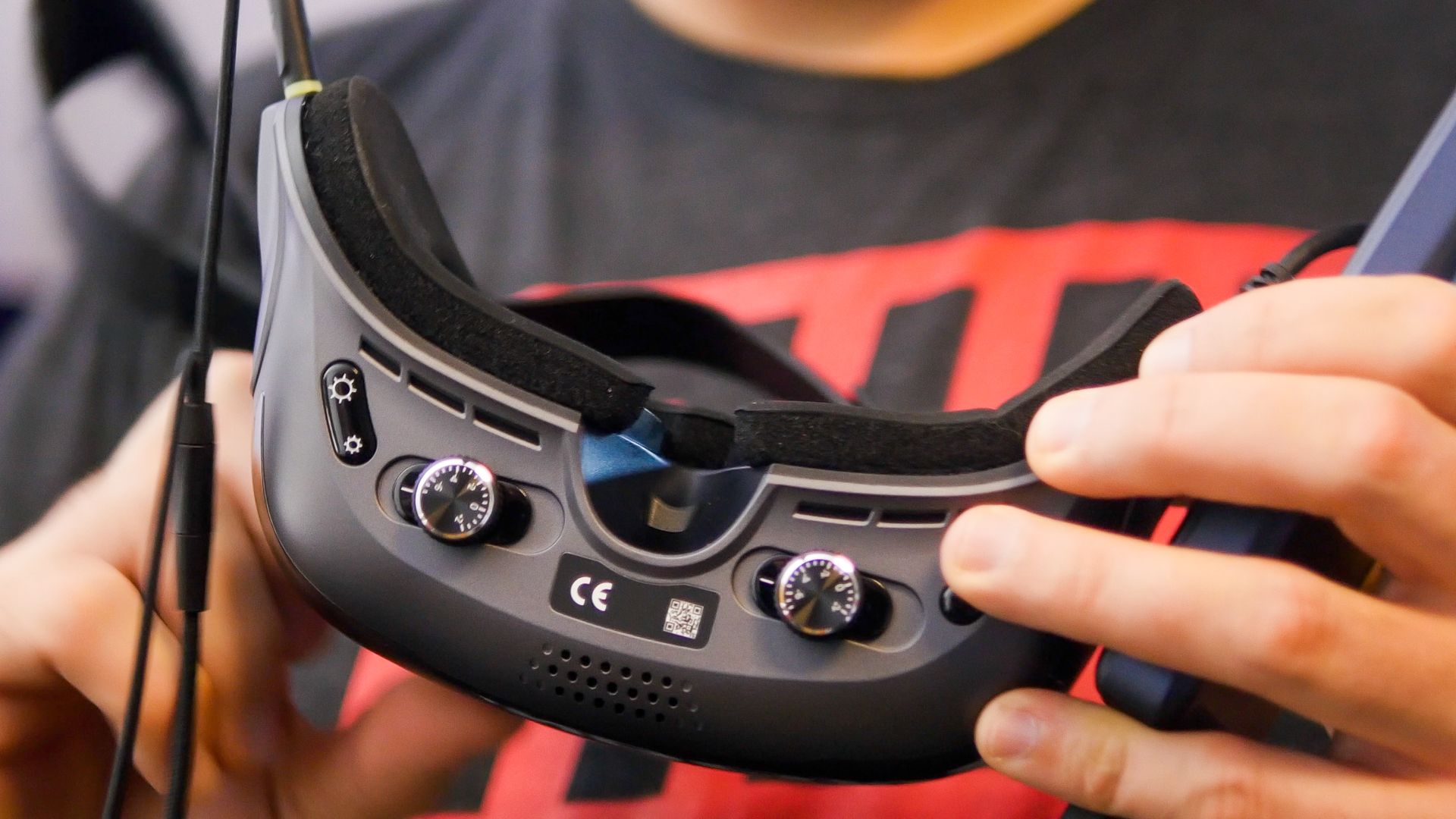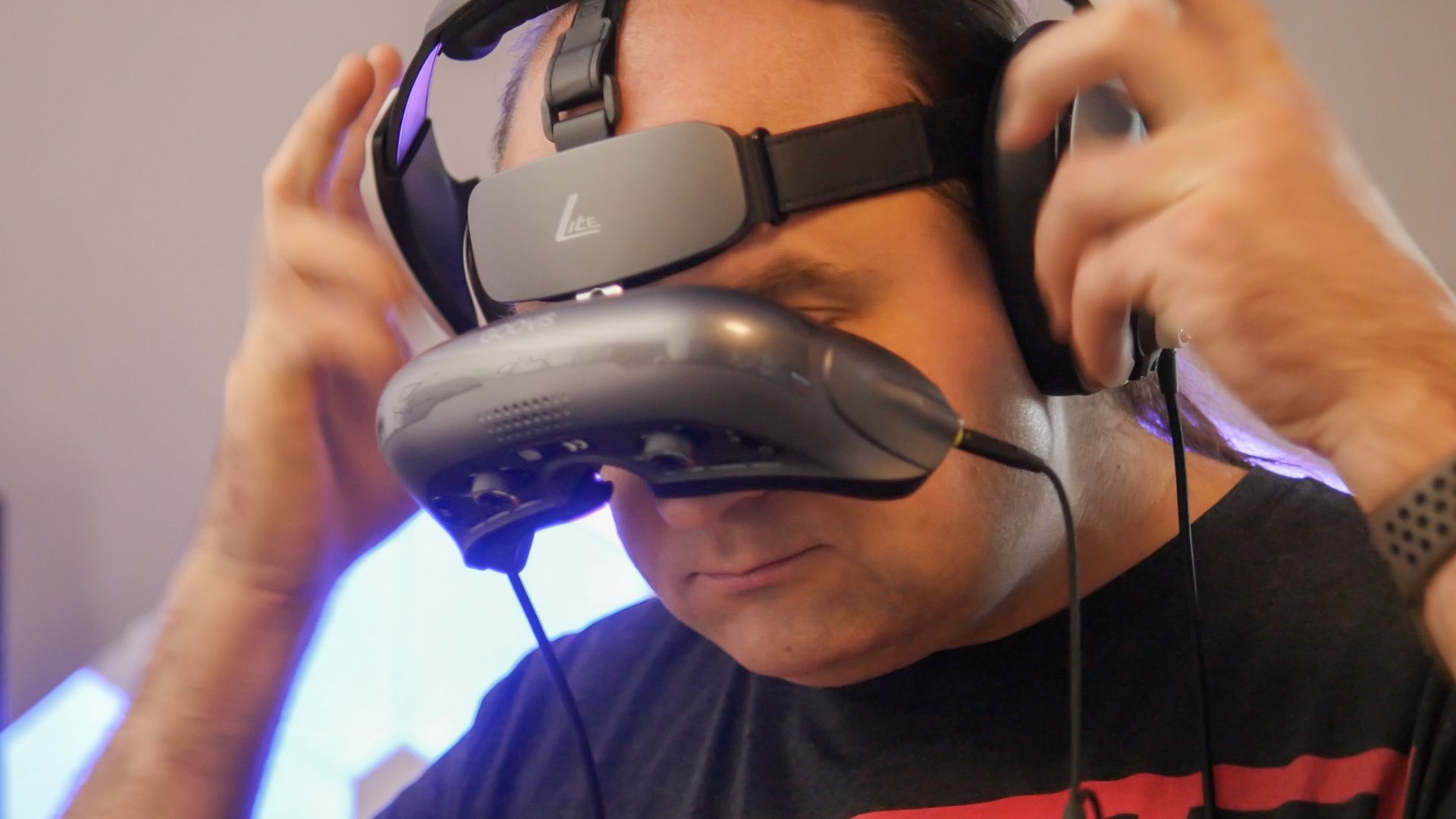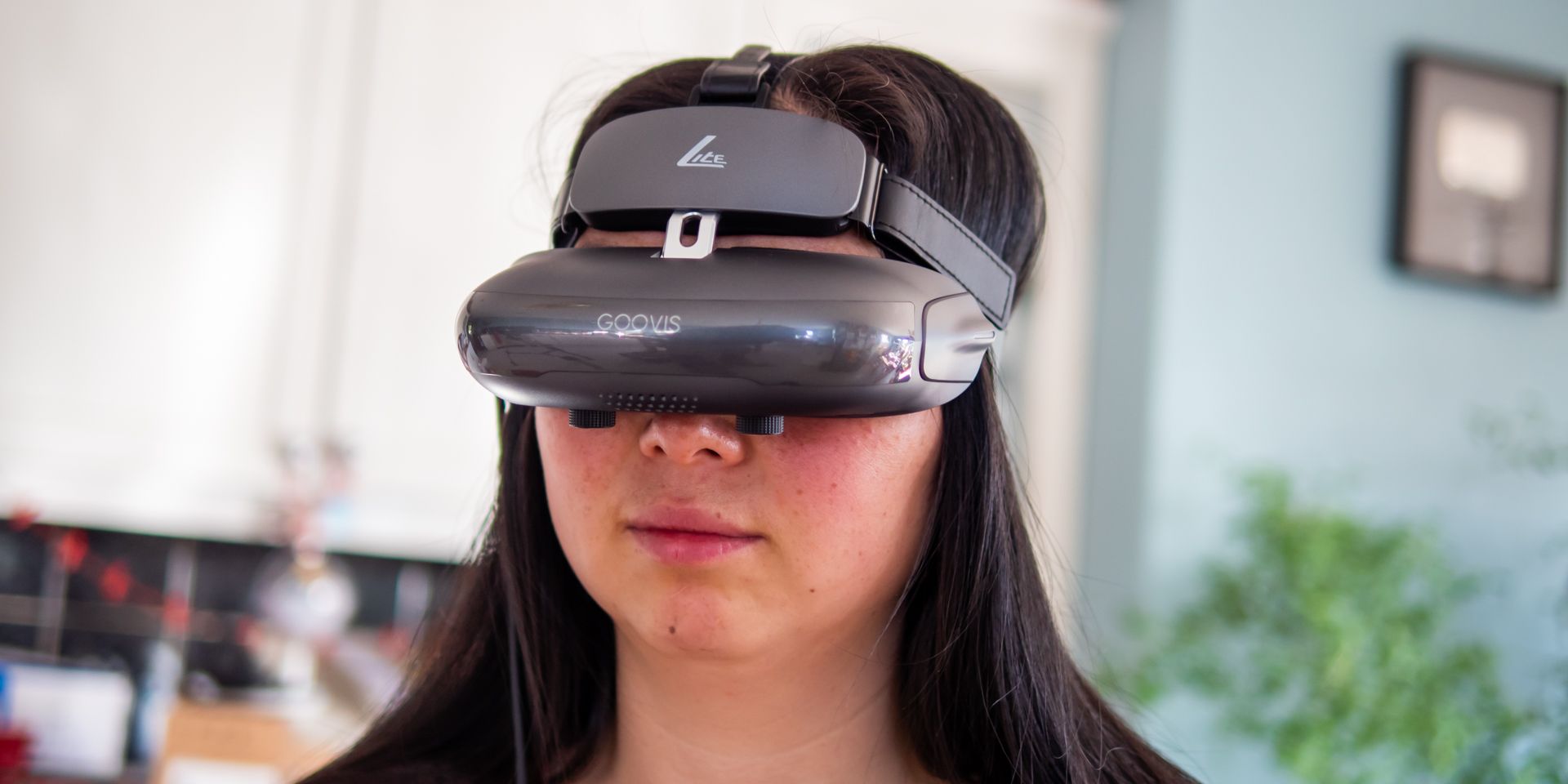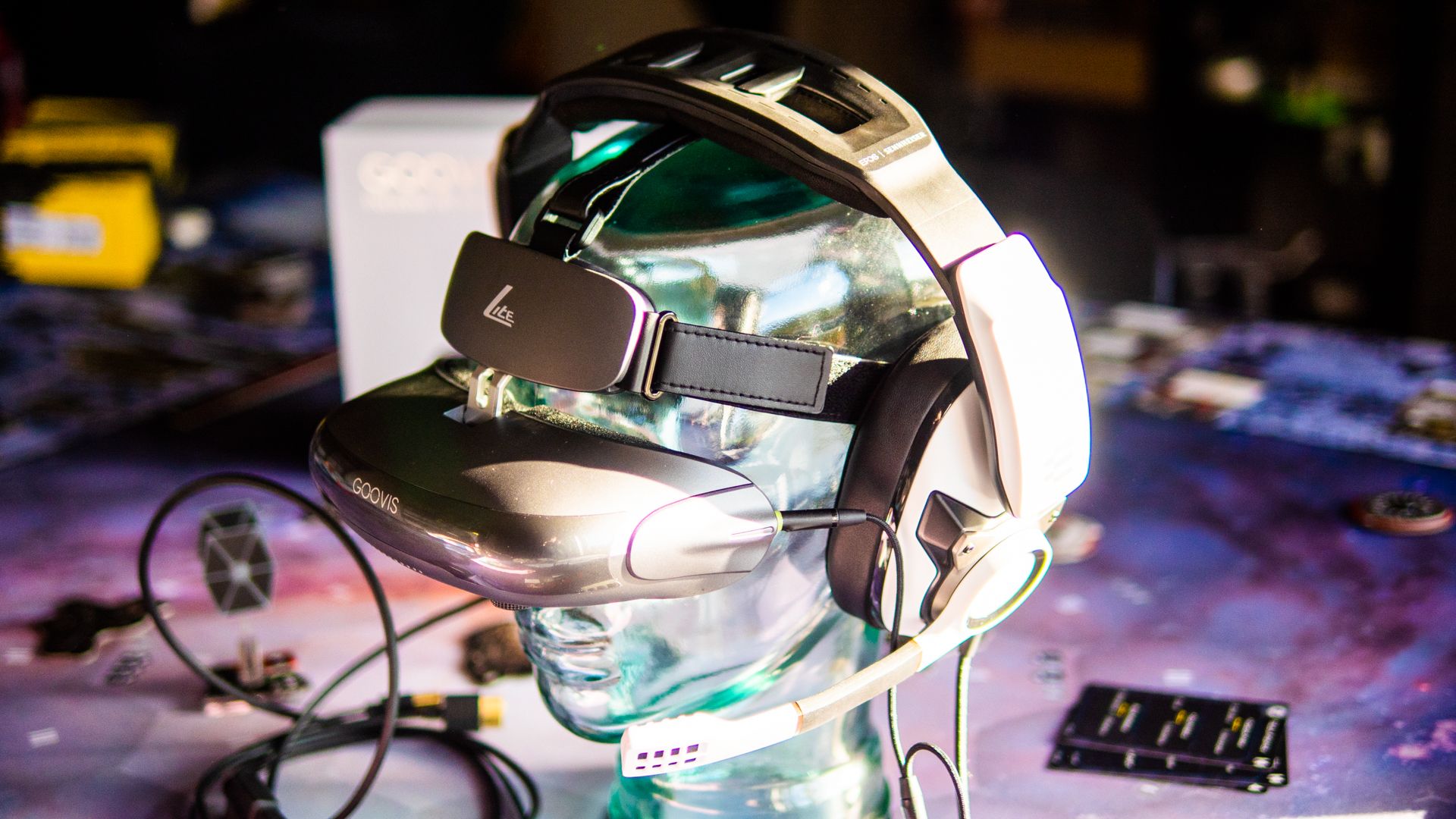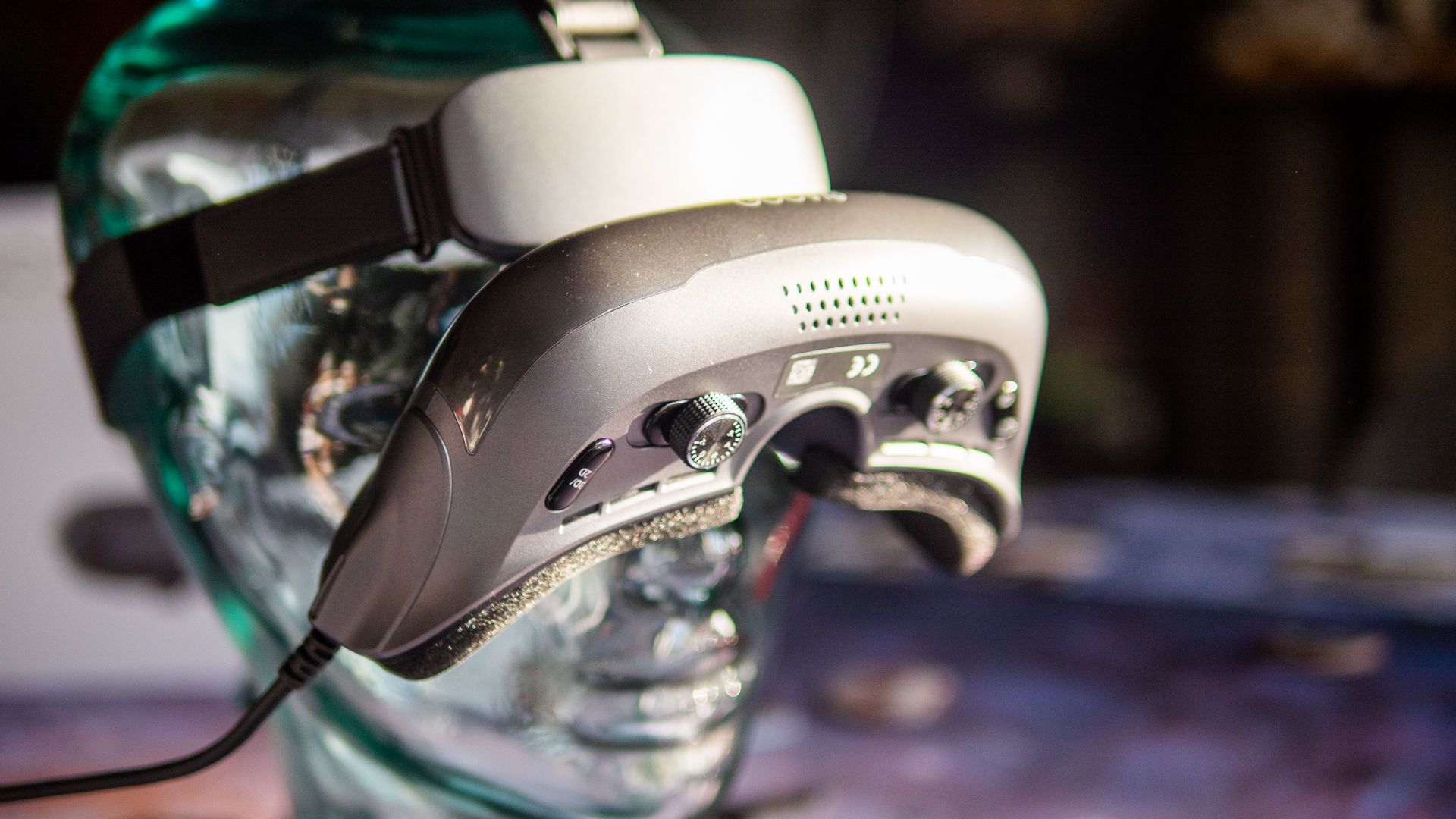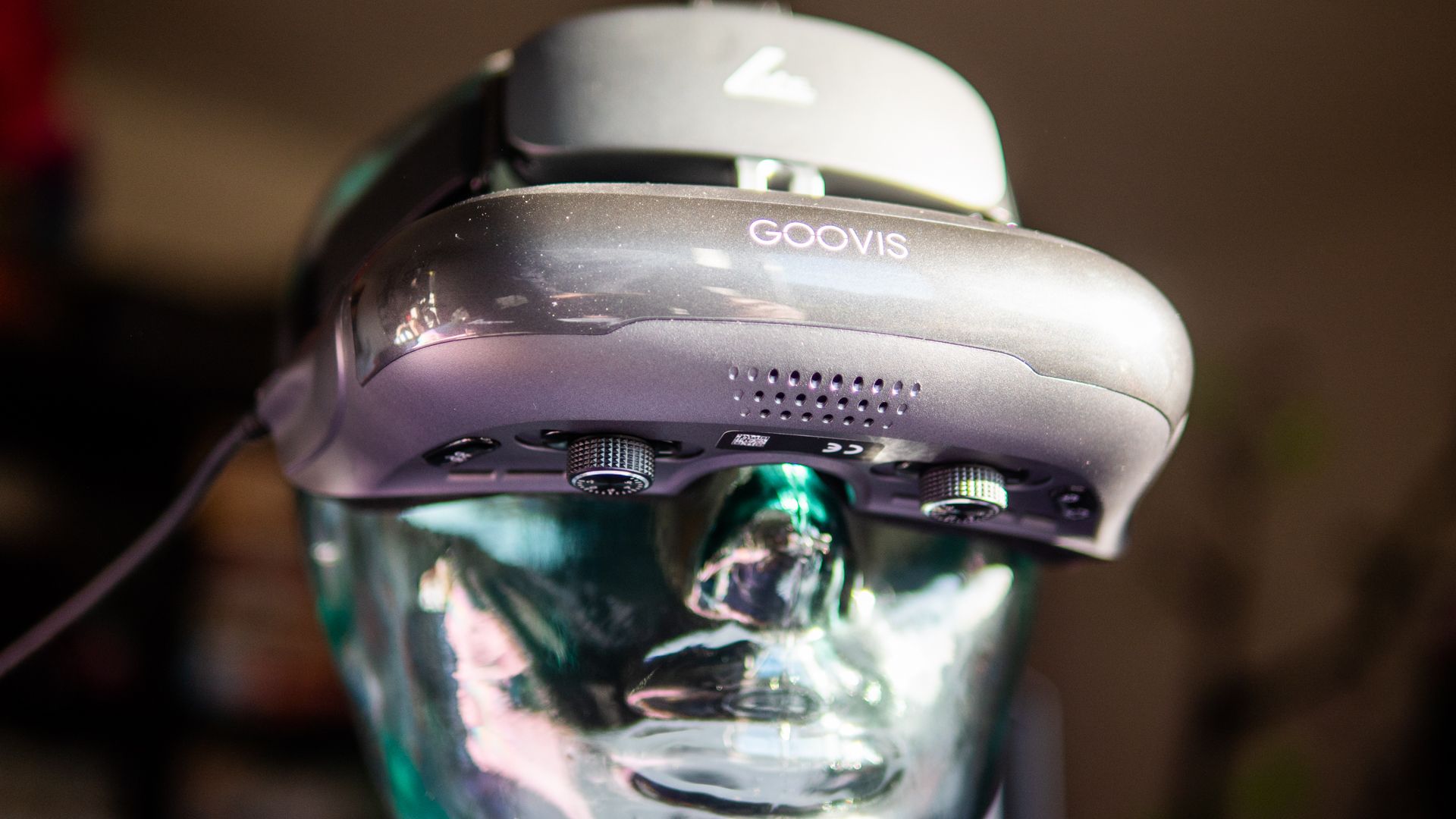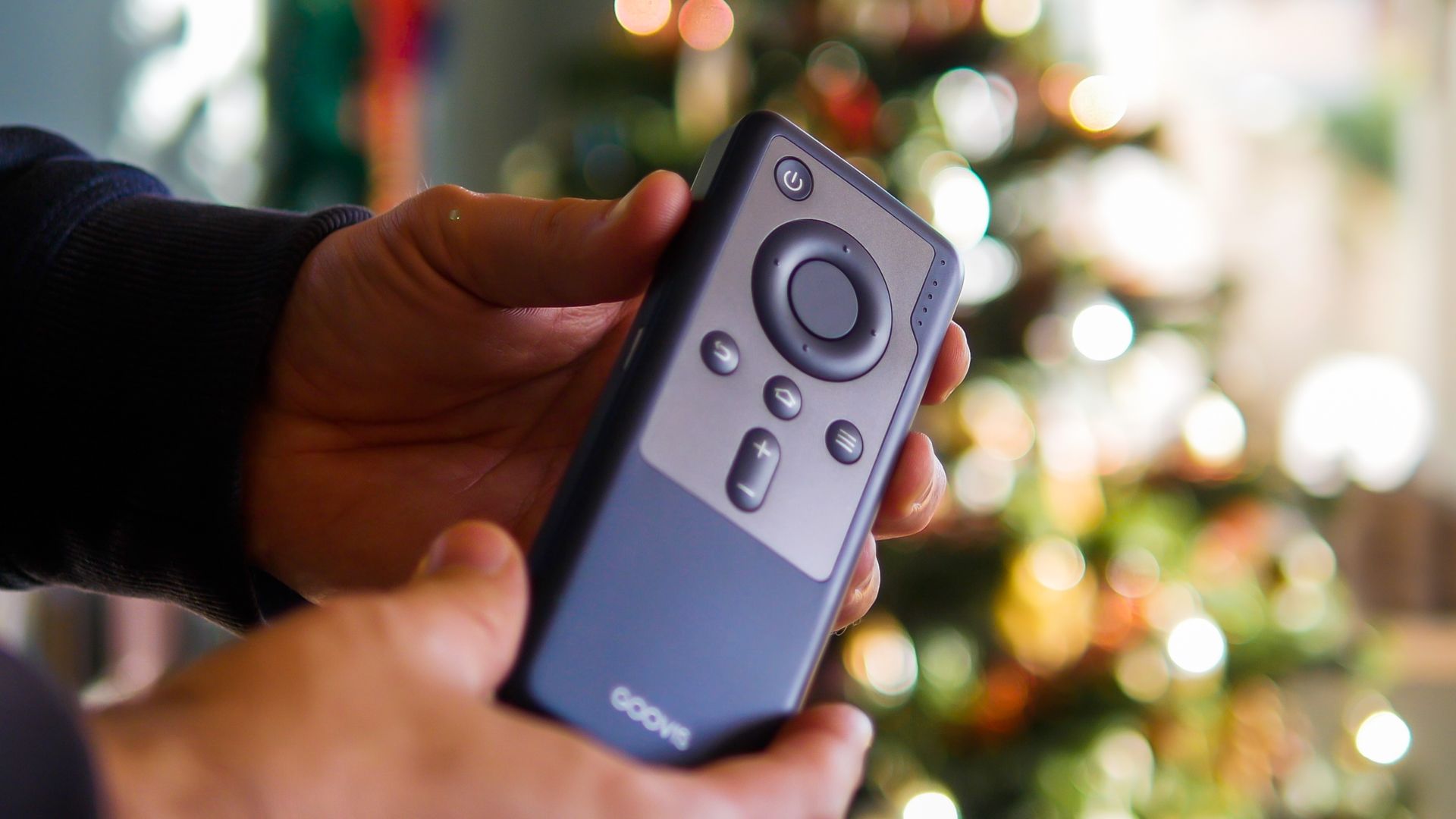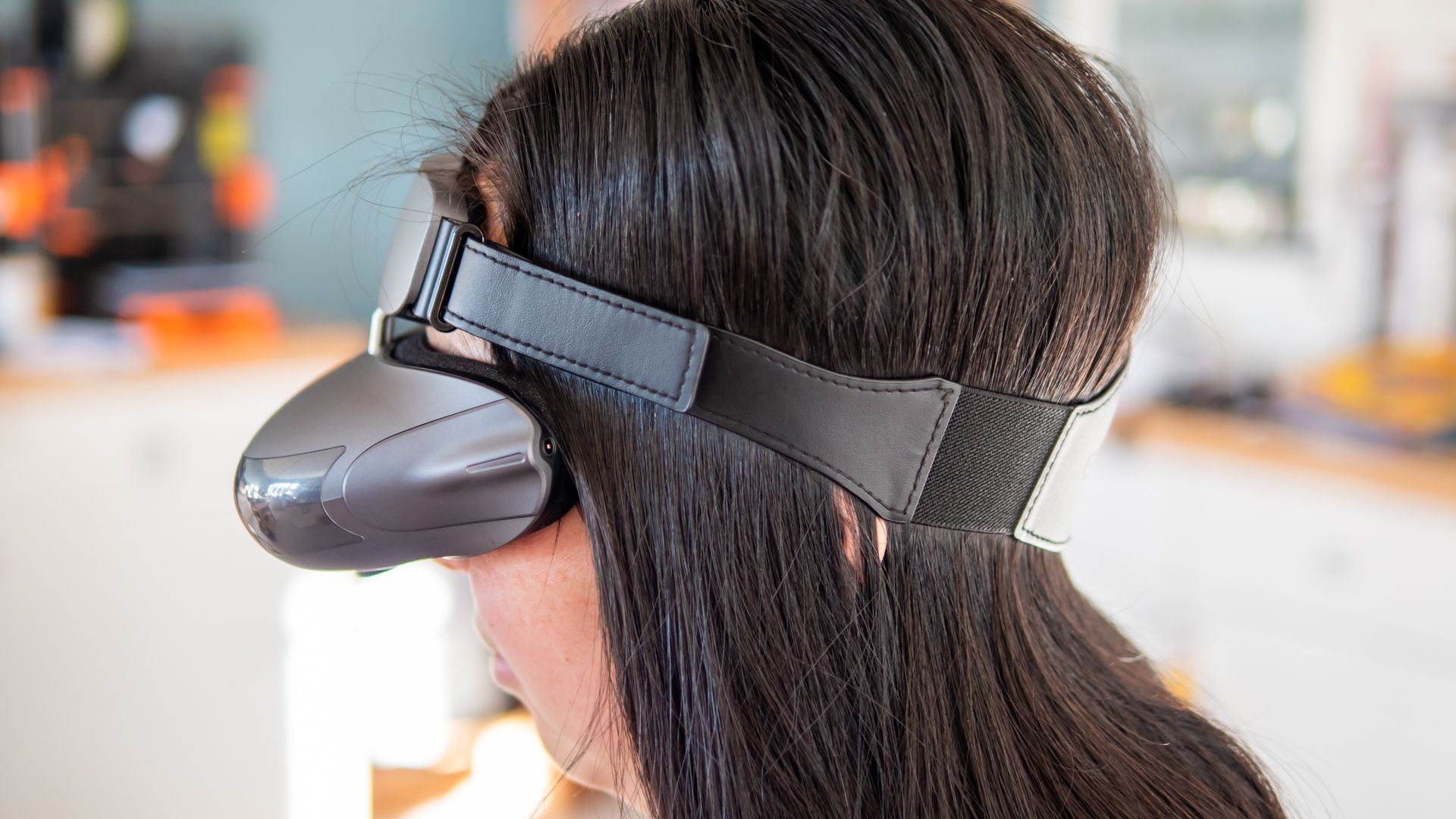Goovis Lite
It's not VR, and by itself can't do anything—it's just a display. But for use as a second (or even primary) monitor, at home or on the go, it allows complete privacy on a large display. Simple to use with an HDMI and USB power cable, it makes a great alternative to a home theater projector if you're tight on space. The ability to use it at any angle also makes it great for those who are less physically able, or just want to game or use a PC in bed.
- Like sitting three feet away from a 27" screen
- Brand: Goovis
- Resolution (per eye): 1920 x 1080p
- Display Type: AMOLED
- Storage: None
- Connectivity: HDMI + USB
- Battery Life: None
- Tracking Technology: Not tracked
- Audio: None
- Weight: 200g (17 oz)
- No need to wear your glasses if your prescription is +2 to -7
- Interface text is perfecttly readable without scaling
- Beautifully sharp display which causes no eye strain
- Lightweight and comfortable to wear for extended periods
- D3 Media Player is great for playing back local files, in 2D or 3D
- Compatible with Side-by-Side format 3D videos
- Great for people with reduced mobility
- No audio
- The D3 Media Player runs ancient software
- It's sold as VR, but isn't
Personal cinema head-mounted displays have always seemed like a bit of a hangover of the before times when 3DTVs were all the rage and VR was but a distant dream. Goovis are experts in the world of optics though, and seem to think that there's still a market for these curious devices. But when faced with the prospect of a $300 Oculus Quest 2, can the $450 Goovis Lite personal cinema HMD stand a chance?
This Isn’t a VR Headset
Since the sales page for this product deceptively mentions “VR”, I want to make it clear that the Goovis Lite is not a Virtual Reality headset by any modern definition of VR. It’s a personal cinema headset, part of a superset of Head-Mounted Displays. VR headsets are also types of Head-Mounted Displays, but that doesn't make them the same.
While the Goovis Lite can display 3D content, that alone doesn’t make it suitable for VR. It lacks the motion sensors required to display different parts of a scene as you move your head around. It doesn't know where you're looking, and your head orientation makes no difference to what is displayed on the screen.
However, I am going to make comparisons throughout this review to VR headsets, notably the Oculus Quest 2, simply because the target markets and some use cases overlap significantly. You can view movies on Goovis Lite, from any external player; you can view movies on the Quest, from the built-in media player. You can use the Goovis Lite as a virtual monitor, directly connected to your PC or games console. You can use the Oculus Quest 2 as a virtual monitor, over the network, or when plugged into a PC.
That's where comparisons end though. Compared to the Quest (or any modern VR headset), the field of view is significantly smaller on the Goovis Lite, at around 42 degrees. To put this in context, Goovis claims that this is comparable to looking at a 600-inch cinema screen from 20 meters away. As someone who hasn't been to the cinema in years, I find that a little hard to visualize, so I used my 27-inch desktop monitor to compare instead. It's like sitting three feet away from that. That's probably similar to what your desktop PC is currently arranged as. That's compared to the 90 degrees or greater field of view offered by an actual VR headset, which is essential to achieve a level of immersion in a virtual world without feeling like you're staring through a small window.
The reason why I'm laboring this point is not to detract from the Goovis Lite—as a personal cinema headset, it has incredible clarity, and the technical quality of the display is superb, and certainly unrivaled by any modern VR headset yet. It's merely to establish that this isn't a VR headset, and shouldn't be marketed as such.
Goovis Lite Design and Specifications
The first thing that will probably shock you about the Goovis Lite is how lightweight it is, at only 200g (7oz), it’s only a little more than your average smartphone. That makes it comfortable to wear for long periods of time, without any neck strain.
The headset secures on your head using some basic but adjustable fabric straps. It looks flimsy, but given the lack of weight it needs to hold, seems to work fine, even while doing some indoor cycling workouts.
The front also flips up (similar to the PSVR) so you can quickly rejoin the real world or look down at your keyboard, or phone. In normal use, the half-inch thick facial interface didn't quite block out everything—there was still a small sliver of visible area on the bottom—but not enough to detract from the main show, and such is the nature of face shapes that your experience will vary.
A proximity sensor turns off the displays when not directly in front of your eyes, preventing screen burn-in and saving power.
The headset itself features a single cable, which initially appears to be an HDMI cable, however, it's designed to carry both power and data, so can't be used with standard HDMI outputs. It can be used in conjunction with the Goovis D3 Media Player directly (more on that later), but for use with anything else you'll need to attach the included breakout cable, which turns the special HDMI plug from the headset, and splits it into a standard HDMI and USB-A plug. The retail version should also come with a carry case, though ours didn't include this.
Goovis Lite Screen and Optics
Powered by dual AMOLED screens, the Goovis Lite features an industry-leading 4496 PPI (pixels per inch), or 46 PPD (pixels per degree). That's at least twice the pixel density as the most popular VR headsets: the Oculus Quest 2 achieves around 23 PPD.
That certainly sounds impressive, but it also makes perfect sense when you consider the field of view for VR covers a much wider area. The Goovis Lite packs the same number of pixels into half as much space, thereby giving it a higher density.
Suffice to say it does look lovely in the relatively small field of view that you have. The Goovis Lite is by far the sharpest looking HMD (head-mounted display) I’ve tried yet. There is no screen door effect at all, the black levels look good, and it's all crystal clear. Goovis claims a 2,000,000:1 contrast ratio, and I have no reason to doubt that (nor any way to verify).
As well as IPD (Inter-Pupillary Distance) adjustments, you can also focus the optics to account for long-sighted vision up to +2, and near-sighted to -7. That means most people won't need to wear glasses at all.
At -1.5 near-sighted, I’m not exactly blind without my glasses, but I do need to wear them in VR due to the far focus of the lenses. It's annoyed me so much that I've had prescription lenses made up for both the Valve Index and Quest 2. With the Goovis Lite, you don’t need custom lenses; they're built-in, whatever your prescription, and even if it's different in each eye.
Running at a resolution of 1080P (locked to 60Hz), the upshot of this is that when connected to a PC or Mac, you can read all standard interface elements and text without needing to scale anything—just as you could on an actual monitor.
That said, I couldn’t quite get the clarity to be completely uniform across the whole display. The extremities tended to be ever so slightly smeared, but not to the point where they weren’t readable. Still, this is infinitely sharper than any VR HMD on the market today, where smearing, "god-rays" from bright lighting, or slight focus issues are just considered par for the course.
Audio on The Goovis Lite
Having discussed the most important part of Goovis Lite—the display—I'll briefly touch on the least important: the audio.
There isn’t any.
There, I told you I'd be brief. Instead, you’ll find a stereo 3.5mm audio jack on the headset, on the left-hand side. Connect any headphones you like. That’s it.
I would have liked to see at least some kind of built-in audio, even if it was as bad as the Oculus Quest and its horribly tinny audio pipes. But no, there’s nothing. This personal cinema apparently wants you to bring your own speakers.
This does help to keep the weight down, of course, and leaves it entirely up to you as to how you handle audio. When used as a desktop display, you may not want audio at all. Used on the go, you might want to use your Apple AirPods while streaming a movie from your iPhone to the Goovis Lite. Or perhaps you'll want your favorite pair of cans when sitting at home on the sofa for some gaming or home cinema use.
What Can You Actually Do With the Goovis Lite?
The sheer simplicity of operating the Goovis Lite is what I enjoyed most about it, but the device by itself doesn’t do anything at all. There’s no built-in battery, there’s no operating system—it’s literally just a display device that straps to your head.
You could use it as a monitor for some extremely private browsing or working while on the go: just plug in the HDMI and USB cable to your laptop, PC, or Mac, and … that’s it. It’s now a monitor, allowing you to focus on the task at hand in complete privacy (just remember to disable your laptop display).
While a headset like the Oculus Quest 2 is also technically capable of being used as a second monitor, in reality, it involves installing additional software, putting both machines on the same network, and suffering from inherent wireless latency. Without scaling I often struggle to read interface text in VR, so I don’t use my Quest 2 as a monitor. On the other hand, I happily sat down with the Goovis Lite and used it for a full day’s work. Well, I say a full day's work, but we all know writing online isn't a real job, is it?
For gaming or movies, if you don’t have the space for a home projector or gaming monitor, the Goovis Lite is a great alternative. You’ll be able to enjoy your content on an immersive big screen, in your own private cinema, at home or even on the go. I tried gaming in Titanfall 2 mostly, and had no issues with latency. It looked so much sharper than it does on my 1080p projector, despite obviously being the same resolution, but it does take a bit of getting used to. Like me, you might be used to glancing at something in the corner of the screen, moving your head to do so. But with the Goovis Lite, the display follows you. This resulted in my head drifting unconsciously to all kinds of awkward angles; at which point I'd have to consciously remember to "reset" my head and save my neck.
I'll also mention that it can be a bit disorienting when playing First Person Shooters, due to the motion mismatch between your head and in-game movements. This is something most new VR users experience too, so you might want to start with games that don't have artificial locomotion.
Goovis D3 Media Player
The Goovis D3 Media Player is essentially a smartphone without the screen, designed to act as both an output device and power source (in the form of an 8000mAh battery) for the various Goovis headsets. It looks like an old-school MP3 player, but with a video output port. It's sold separately for about $250, or in a bundle with the Goovis Lite for $650.
It has the usual assortment of volume, home, back, and menu buttons; a D-pad for easy menu operation; and even a hidden touchpad on the lower half of the front face, for other complex selections or faster virtual keyboard use.
Internally, the Goovis Player runs at 1.8GHz, with 2GB of RAM and 24GB of usable internal storage. There's a microSD slot for extra storage, and while you also connect it via a USB-C port for file transfer, I found the easiest way was simply to load up files onto a card. Goovis claims the 8000mAh battery should provide up to 10 hours of playback, though I found more like 6 to 8 hours. Turning off Wi-Fi or reducing the brightness would improve this.
On the base of the player is an HDMI port, USB-A port, and 3.5mm stereo jack (though I was unable to get any audio out of that). Connecting to the Goovis Lite requires only the HDMI cable that’s built into the headset, leaving the USB port free for accessories or even more storage.
The D3 Player runs a custom Android 7 OS, with the last security update in 2018. Whether or not you want to risk putting this device on the internet is up to you, but without doing so, you’re missing out on a range of features, as well as obviously any network connectivity. At the very least I suggest you only stick to official legit apps from the Google Play store and don’t consider installing random APKs.
The Android 7 OS is basic, but functional. The home screen contains a link to “Online Videos”, which turned out to just be Netflix. Given that Netflix isn’t certified on this device and can’t be downloaded from the Google Play Store, it likely only supports SD 480p resolution, not HD. This is similar to nearly all Android TV boxes, but it's nice that it's pre-installed, saving you from seeking out an unofficial APK.
You can also use the local video player option too, which handled any kind of video I threw at it, including 3D side-by-side formatted videos. For 3D content, just hit the button on the underside of the HMD to go into 3D mode. Alternatively, you can download your favorite apps from the Google Play Store.
Not everything will be compatible however, given how old the Android version is. Plex is my go-to media app, and while it downloaded fine, anything with 5.1 surround audio was unable to mix down to stereo, so it played in silent. The same video files played fine on the local player. 4oD wouldn't install at all, and BBC iPlayer installed, but was plagued by a curious ghosting effect in all the shows I tried (not something I saw on other videos). YouTube was fine.
In short, if you stick to local files, the player works great, and connecting to the Goovis Lite headset is simple thanks to using a single cable. For streaming apps though, it's very hard to recommend the D3 Player. The hardware is antiquated, the software is even older, and the whole thing is in dire need of a refresh.
If you already have an Android or iPhone that you know you can get an HDMI signal out of with a suitable adaptor, that's your best option. But bear in mind you'll need to use the splitter cable, and provide USB power too, probably through a portable power bank.
Repairability
Although we didn’t get a carry case with our package, you should get one through retail and it's by far the best way to protect the HMD when not in use.
As with all HMDs, there's one thing you absolutely mustn't do: allow direct sunlight to hit the lenses. They will act as a magnifying glass, and in mere seconds your screens will be permanently damaged. Always keep the lenses facing downwards when you’re holding it.
Other than a cooling fan, the device itself has no moving parts or battery, so it stands a good chance of lasting quite a long time. My main concern would be for the one and only HDMI cable. It’s built-in to the headset, so if there's any damage, it can't be replaced. Don't fall asleep with the headset near you, or there's a chance you'll roll onto the cable, stressing the thin internal wires and solder joints inside the headset.
In summary, there’s very little that should go wrong with the Goovis Lite, but if it does, it’ll be either sun damage through user carelessness, or cable damage, neither of which will be user repairable. Beyond hardware durability, there's a good chance it'll simply be made redundant by newer technology, as HMDs are still very much in the rapid development stage.
Should You Buy the Goovis Lite?
At around $450, it’s hard to recommend the Goovis Lite for most people, who would probably be better served by an actual VR headset. The Oculus Quest 2 is available for two-thirds that price, and opens up a virtual world of gaming, socializing, exercise, and more.
But if you just want a portable head-mounted display, into which you can feed in anything with a generic HDMI output, the Goovis Lite is a great choice. For watching movies or flatscreen gaming (or even 3D if it does SBS output), it looks incredible. The dual AMOLEDs produce a simply beautiful display. You're just not going to get this sort of clarity or brightness from any current generation VR headset.
If you carry a laptop around for work and need a little privacy or better focus, the Goovis Lite is a simple-to-use, portable, private, personal monitor. Since it works at any angle, I can also see a great benefit in the accessibility sector for those who are bed-bound. It's lightweight, you can use it without glasses for all but the most extreme prescriptions, and Goovis assures me they've just been awarded Low Visual Fatigue certification by SGS. Which all sounds rather good.
You may also want to buy the Goovis D3 Media Player for the most portable experience, but only if you have local files you can transfer onto it to watch on the go. Don't assume your favourite streaming service will work. At $650 total for that bundle, you’d need to be travelling a lot to make it worthwhile.
So if you can’t abide by seeing pixels and you only want to watch movies or use it as a private monitor, then the Goovis Lite is absolute the way to go. Forget 4K, because the HD on this looks just as good as any 4K TV. Remember to bring your own headphones though, or you'll be watching a lot of silent movies.

